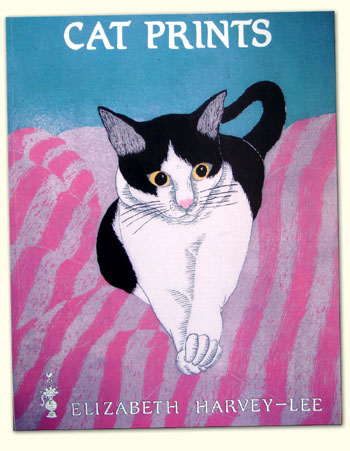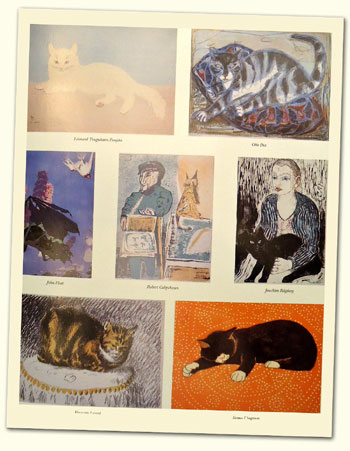|
CAT
PRINTS
 Graphic
images of Cats, Graphic
images of Cats,
prints from the
16th – 20th Centuries
Though
traditionally the cat has been held to be the ‘familiar’ of
witches, it might equally be so described in relation
to artists. Erasmus Darwin wrote To respect the cat
is the beginning of the aesthetic sense, while Desmond Morris
observed Artists like cats; soldiers like dogs and in
the opinion of Leonardo da Vinci The smallest feline
is a masterpiece. The American Pop artist Robert Indiana
noted After all, a cat and art are only two letters
removed.
One feels when artists include a cat in their compositions,
or make the cat their specific subject, that the cat
portrayed is a part of their household.
It
is strange that P G Hamerton, an enthusiast for etching
and the graphic arts and a contemporary of Manet, should
have opined It is odd, notwithstanding the extreme
beauty of cats, their elegance of motion, the variety
and intensity of their colour, they should be so little
painted by considerable artists. In terms of printmaking
this claim does not stand up; some of the greatest
printmakers have included cats in their prints, Dürer, Barocci, Bellange,
Callot, Rembrandt, Hollar, Goya, Manet &c. The instance
of cat prints increases sharply from the end of the 19th
century, after Hamerton made his comment.
Cats
appear in prints before the end of the 15th century,
very shortly after the invention of the earliest intaglio
technique, line engraving. Their presence, particularly
in Northern Europe where they appear first, is however
at this period generally symbolic. Perhaps the earliest
example of an engraved cat is in Israhel van Meckenem’s
engraving ‘The Visit to the Spinner’, c1495-1503,
which includes a cat resting on the floor in an interior
with a woman sitting spinning accompanied by a man seated
holding his sword by the hilt point-down on the floor
between his feet. From a series formerly considered as
straight-forward scenes of daily life but now interpreted
as expressions of different sorts of love, this image
represents illicit love. The cat was traditionally a
medieval symbol of lust, while prostitutes were nicknamed ‘cats’ and
brothels ‘cathouses’. The presence of the
cat in Meckenem’s engraving points to the reason
for the man’s visit to the woman spinning.
However,
in the 16th and 17th centuries a cat is often included
in prints of general scenes of women spinning without
any overtones of illicit or ‘commercial’ sexual
reference. Girls were taught to spin to fit them for
the virtuous household duties of marriage, hence the
term ‘spinster’ for an as yet unmarried woman.
The
visual symbolism associated with cats is complex and
sometimes contradictory, reflecting various aspects
of their innate characteristics and not just feline
sexual proclivities. Their greed for food and lack
of guilt at stealing it saw them included in kitchen
scenes. Brueghel’s ‘Rich
Kitchen’, engraved by Pieter van der Heyden in
1563 has a cat, while the ‘Poor Kitchen’ is
without. Their nocturnal habits suggested night and darkness
and by association evil, the Devil and witchcraft; but
equally sleep. Despite this bad press and often being
only grudgingly valued as pest controllers, the quiet,
self-contained, contemplative, companionable nature of
the cat also occasionally attracted old master printmakers’ attention.
A cat reposing or curled up asleep emanates security
and the comfort of home and hearth and invites being
drawn.
The
Italian School seem most open to this domestic aspect
of the cat’s nature. A delightful little etching
by Giulio Campagnola, c1515, shows a fat baby seated
on a step whispering into the ear of one of a group of
three fat cats sitting on a ledge. Eneo Vico’s
engraving of the 'Academy of Baccio Bandinelli', c1552,
has a cat at the feet of the apprentices who sit drawing
in front of the fire. Federico Baroccio included a sleeping
cat curled up on a chair in the corner of his ‘Annunciation’ etched
c1585. When Goltzius engraved his series of ‘The
Life of the Virgin’, 1593, his master-pieces in
imitation of six great masters, he included a less innocent
cat on a window sill springing up to catch a bird between
it front paws in ‘The Holy Family’ engraved
in imitation of Baroccio. Several other prints of the
holy family include an incidental cat. Jacques Bellange
shows a cat beside the cradle in his ‘Virgin and
Child with a Cradle’, c1600-1610. Rembrandt’s
friend Ferdinand Bol, c1645, and Rembrandt himself, 1654,
both etched the holy family in interiors with an attendant
cat. The cat is nowhere mentioned in the Bible but from
the 16th century is portrayed in biblical subjects, particularly
those given a contemporary interior setting.
 In
the mid-17th century appeared two prints which are
exceptions to the general old master sidelining of
cats. Wenceslaus Hollar and Cornelis Visscher each
portrayed a cat as the specific subject of a print
(catalogue items 6 & 9), though even here Hollar’s cat is surrounded
by the inscription It’s a good cat that doesn’t
steal tidbits and the setting by a grating with the cat
oblivious of the mouse behind him in the Visscher engraving
suggests the possibility of an ulterior, hidden meaning. In
the mid-17th century appeared two prints which are
exceptions to the general old master sidelining of
cats. Wenceslaus Hollar and Cornelis Visscher each
portrayed a cat as the specific subject of a print
(catalogue items 6 & 9), though even here Hollar’s cat is surrounded
by the inscription It’s a good cat that doesn’t
steal tidbits and the setting by a grating with the cat
oblivious of the mouse behind him in the Visscher engraving
suggests the possibility of an ulterior, hidden meaning.
Emblem
books had been popular since the later 16th century
with their moralising images which had several layers
of meaning. Cats (in an age before neutering) featured
in these illustrations usually as the subjects of amorous
aphorisms. Cats also appeared in printed illustrations
to popular collections of satirical fables, “Reynard
the Fox”, the “Fables” of La Fontaine
and their prototype Aesop’s “Fables”.
Pictorially cats lend themselves well to anthropomorhism
and were also treated in this manner in independent prints
(items 14,22,29).
The
illustrations (items 10,11) to Count Buffon’s “Natural
History”, the first encyclopaedia of the animal
world, from the later 18th century, anticipated a new
interest in cats as print subjects in their own right;
a move from the cat as symbol to the cat as model. Gottfried
Mind in the early 19th century was the first artist to
dedicate himself to the cat as a theme. In admiration
of his skill and observation, capturing cats in action,
at play, fighting, as well as at rest, his contemporaries
gave him the sobriquet Raphael of the Cats. Though not
himself a printmaker, publishers commissioned engravers
to etch his drawings and watercolours (items 17-20).
Queen
Victoria helped to make cats fashionable pets. She
kept Persians. Pasteur’s publication in 1865
on the transmission of diseases and the benefits of hygiene
further contributed to the cat’s elevation from
the kitchen to the drawing room; feline cleanliness and
fastidiousness being their passport. The growing popularity
of cats in middle class homes led to a demand for decorative
pictures and prints of cats (items 23-26).
Artistically
the cat came into its own in fin de siècle France
(one of the Montmartre cabarets was called Le
Chat Noir, The Black Cat, and published a periodical
of the same name whose pages were decorated with images
of cats by notable artists of the day). Cat prints proliferated
throughout Europe in the early decades of the 20th century.
Published
2000
64 pages, 126 items described and illustrated in black & white, 8 in colour.
(UK
Price: £10, International orders: £15)
|
|
Artists
included in the catalogue:
- Aldous
W
- Allingham
H
- Anderson
S
- Baer
M
- Baquoy
J C
- Berger
G
- Bloemaert
C
- Bloemaert
F
- Bodmer
K
- Bonnard
P
- Bresslern-Roth
N von
- Brightwell
L R
- Bodribb
G M
- Brooks
M
- Brueghel
P
- Callet-Carcano
M
- Cardon
A
- Chahine
E
- Colley
W F
- Colqhoun
R
- Couché J
- Delaune
E
- Detmold
E J
- Dix
O
- Dodd
F
- Dunoyer
de Segonzac A
- Elstrack
R
- Foujita
L T
- Frood
H
- Gill
E
- Gill
P
- Girdwood
S
- Goeneutte
N
- Goya
F
- Grant
D
- Green
A
- Green
G
- Halm
P
- Hamilton
I
- Hamson
T D
- Harvey
J H
- Hegi
F
- Hollar
W
- Hughes
P
- Kempster
A B
- Komjáti
J
- Lambert
P
- Laprade
P
- Legrand
L
- Lempereur
L S
- Lindsay
L
- Loevy
E
- Manet
E
- May
E G
- McEntee
D
- Menpes
M
- Miel
J
- Mind
G
- Monogrammist
DAC
- Morgan
G
- Morisot
B
- Murray
C O
- Muyden
H van
- Nash
J
- Nash
P
- Nemes-Ransonnet
E
- Niekerk
S
- Paterson
V
- Petterson
M
- Phipps
H
- Pimlott
P
- Platt
J
- Plückebaum
M
- Possoz
M
- Prevost
B I
- Rágóczy
J
- Reiner
I
- Rowlandson
T
- Royds
M
- Schenau
J F
- Sève
J de
- Simpson
J
- Smallfield
F
- Steinlen
T A
- Stiles
S
- Tavener
R
- Teniers
D
- Thomas
M F
- Tournour
M
- Turner
L
- Utagawa
T
- Vegter
J
- Vernet
C
- Visscher
C
- Zorin
L
Return to the top |